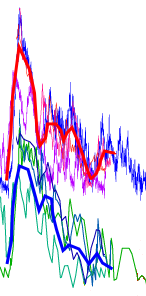This is a repeat of the article in which I describe how temperature and CO2 are not correlated around 16,000 years after the inter-glacial peak.
For those not familiar with my sense of humour the “Haseler Gap” also refers to the lack of understanding and disappointment with conventional climate research that I felt when I wrote the article.
See also
- Introduction
- Criteria for Cycles
- Global warming and earthquakes
- Thermal crust expansion, decomposition and the Carbon cycle
- Overview of feedbacks
- Climate stability
- Hitting the buffers
- How CO2 could control climate
- Drying of climate
- 5million years of cycles
- Hadley Cell

Fig 12.1 Global temperature (top red) and CO2 (bottom blue) from Vostok Ice cores aligned and averaged.
To the right I have my (hurriedly prepared) graph taken from the Vostok ice cores, showing temperature at the top and CO2 at the bottom shown over roughly 100,000 years of the typical (later) ice-age cycles. The problem is that whilst all show a very sharp rise in temperature very closely coinciding with a rise in CO2, temperature after hitting a peak clearly then has a rapid cooling phase which does not occur with CO2. So in the 16,000 years after the peak, we effectively progress more and more into an ice-age (and no, I’ve not worked out whether we are in the phase).
However that temperature drop occurs without an associated drop in CO2. But if CO2 were driving the temperature, then we must see a drop in CO2 associated with the drop in temperature. So, the lack of change in CO2 at a time temperature drops massively (in each of the last four cycles) is unequivocal proof that CO2 “did not do it”. CO2 was not driving the ice-age cycle.
So, in no shape or form can CO2 be said to be directly “causing” the temperature change through the ice-age cycles. And if temperature plummets after the inter-glacial peak uncorrelated with CO2, then the rise into the inter-glacial cannot be directly associated with CO2. And so as these ice-age cycles are the main reason massive positive feedbacks from CO2 are postulated, this single piece of evidence can be said to undermine the credibility of positive feedbacks directly from CO2.
This more or less rules out any mechanism whereby the level of CO2 directly controls climate via the commonly suggested feedback mechanisms of Albedo & changes in cloud cover. This is because the such a feedback mechanism is like a sea-saw. One end cannot change without the other also changing.
However …
It is possible that CO2 is not in itself the sole driver of climate, but is in some way part of a combination of factors that control the climate or indeed that it is a proxy for some factor.
Let us postulate a simple relationship that both CO2 (or a factor that leads to higher CO2) and the unknown X are necessary. So we can write a simple truth table:
| CO2 | Unknown | Global Temperature | |
| Low | Low | Low | |
| Low | High | Low | |
| High | Low | Low | |
| High | High | High |
When CO2 levels are low, it appears that nothing is able to increase the temperature because the temperature stays stubbornly low. But when CO2 levels increase the temperature initially rises … but then falls … indicating that whilst rising CO2 (or a factor leading to rising CO2) is necessary to see a rise in global temperature, it isn’t sufficient on its own to cause a higher temperature.
So, what climatic factors could be affected by CO2 that are also affected by other factors that change over the period of ice-ages? The obvious answer is plant growth. What e.g. if a drop in plant growth led to global cooling? Then not only would a drop in CO2 lead to reduced plant growth but also a general drying of the climate might independently lead to a drop in plant growth. Moreover, as the common garden greenhouse shows, plant growth is also strongly affected by temperature such that for maximum growth we need a combination of:
- High enough levels of CO2
- + High enough levels of water
- + High enough temperatures
- + other nutrients.


Pingback: The theory that will bring down global warming | Scottish Sceptic